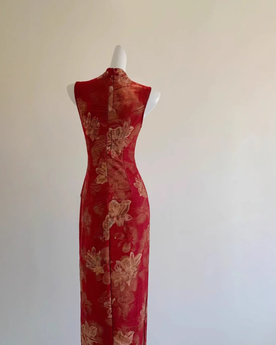Satin Qipao: Liquid Moonlight, Frozen Time
This article explores the enduring allure of the satin qipao, tracing its journey from traditional craftsmanship in Jiangnan's silk villages to modern fashion runways.
QIPAO FABRIC
6/5/20253 min read


The Silken Code: From Silkworm Cocoon to Catwalk
The soul of satin qipao begins in Jiangnan's silk villages, where the rustle of mulberry leaves heralds metamorphosis. After cooking cocoons, reeling silk, and winding threads, raw silk emerges, ready to be woven into fabric. When interlaced in satin weave—where warp floats dominate the surface—it births the mirrored luminosity that defines qipao elegance, yet subtly gathers light at its curves, embodying the "less-is-more" philosophy akin to ink-wash painting's "liubai" (空白).
Masters say, "A bolt of fine satin must withstand the three-zhang light test." Held thrice a man's height away, true satin retains its moonlike glow—a testament to craftsmanship. This pursuit of luminous perfection allows the fabric to ripple like West Lake waters under lamplight.
The Cutting Philosophy: A Tightrope Between Restraint and Sensuality
The allure of satin qipao lies in its ability to narrate complex bodily stories through minimalist lines. Traditional "pingcai" (flat cutting) molds fabric to form through "guiba" (draping) rather than rigid darts, creating a second skin that hugs the body with Eastern subtlety.
Modern tailoring injects new vitality. Designers merge laser precision with heritage silhouettes, achieving 0.1mm accuracy to trace spinal curves. When the wearer turns, the backline slices like a calligraphic brushstroke, while the front slit teases with "yinyu" (隐现)—the art of revealing through concealment.
Chromatic Revolution: From Moonlight to Neon
The traditional satin qipao palette reads like a poet's lexicon: moon-white, crow-azure, indigo, autumnal fragrance... Each hue, borrowed from nature, carries literary resonance. Eileen Chang once captured its dramatic tension with "scallion-green paired with peach-red"—a study in contrasts. Today, designers push boundaries: Guo Pei coats satin in metallic galactic hues, while Uma Wang ages it with botanical dyes, cultivating temporal rings on cloth.
The boldest experiments merge technology with tradition. "Thermochromic satin" shifts from frost-white to cherry-blossom pink under body heat, transforming the qipao into a wearable emotion-visualizer—Eastern understatement reborn as contemporary art.
Modern Metamorphosis: From Ceremony to Street
On 21st-century streets, satin qipao transcends context. Feng Chen Wang fuses ripstop nylon with silk, creating machine-washable "urban qipaos" for subway commutes. Chen Zhen's "Cyber Qipao" embeds LED strips, turning frog buttons into data ports and slits into neon revelations—a dialogue between heritage and futurism in nightclubs.
This contextual shift is most vivid in weddings. Brides reject monolithic red satin for champagne, haze-blue, or low-saturation tones, turning toast gowns into self-expression canvases. Custom brands report 300% growth in millennial brides choosing modernized satin qipao, declaring: Tradition isn't a museum piece—it's contemporary life's poetic core.
The Custodial Alchemy: Letting Time Breathe
Satin qipao demands slow care, like a love letter needing tender care. Clean with horsehair brushes, launder below 30°C with silk detergent, and dry flat in shade to prevent irreversible creases.
A poetic ritual is "wearing-in" : natural body oils nurture a patina over decades, a process called "skin conditioning" that deepens luster. As collector Ma Weidu notes, "A fine qipao is worn, not stored."
In a fast-fashion world, satin qipao persists as a slow-burning narrative. From silkworm to runway, from Republican divas to modern mavericks, it remains a living artifact of Oriental aesthetics. As we fasten the last frog button, the fabric reflects not just light, but a century of temporal alchemy—the quiet testament of civilizations dressed in silk.
In the glow of Shanghai's Paramount Ballroom during the Republic era, a spotlight chased the shimmering ripples of a satin qipao as it swirled across the dance floor. That lustrous sheen—a dialogue between silk and neon—embodied the entanglement of Oriental aesthetics and modernity. The satin qipao, a sartorial icon bearing a century's worth of elegance, continues to write timeless love letters to the East, whether on red carpets or city streets.


